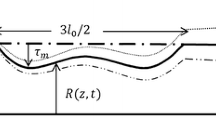Abstract
Based on an improvement of the Karman-Pohlhausen’s method, using non-linear polynomial fitting and numerical integral, the axial distributions of pressure and its gradient in an axisymmetric rigid vessel with stenosis were obtained, and the distributions related to Reynolds number and the geometry of stenotic vessel were discussed. It shows that with the increasing of stenotic degree or Reynolds number, the fluctuation of pressure and its gradient in stenotic area is intense rapidly, and negative pressure occurs subsequently in the diverging part of stenotic area. Especially when the axial range of stenosis extends, the flow of blood in the diverging part will be more obviously changed. In higher Reynolds number or heavy stenosis, theoretical calculation is mainly in accordance with past experiments.
Similar content being viewed by others
References
Liu Zhaorong. Cardiovascular Fluid Dynamics[M]. Fudan University Press, Shanghai, 1986, 130–160 (in Chinese).
Lee J S, Fung Y C. Flow in a locally constricted tube at low Reynolds number[J]. Journal of Applied Mechanics, 1970, 37(1):9–16.
Wu Chi, Liu Zhaorong. On the influence of arterial stenoses on the blood velocities[J]. Journal of Shanghai Mechanics, 1995, 16(3):192–199 (in Chinese).
Ding Guanghong, Liu Zhaorong. An analysis of flow in a mild stenosis blood vessel[J]. Journal of Biomechanics, 1989, 4(6):30–39 (in Chinese).
Lu Lan, Xu Shixiong. An analysis of pressure and pressure gradient of pulsation flow through an elastic straight vessel with a mild stenosis amplitude oscillating in radial direction[J]. Journal of Applied Biomechanics, 1999, 14(3):144–151 (in Chinese).
Forrester J H, Young D F. Flow through a converging-diverging tube and its implications in occlusive vascular disease[J]. Journal of Biomechanics, 1970, 3(3):297–310.
Qin Jie, Liu Hui, Sun Lizhong et al. The distributions of pressure in blood vessel with rigid stenoses[J]. Journal of Biomechanics, 1989, 4(6):57–61 (in Chinese).
Oka S. Biorheology[M]. Wu Yunpeng, Tao Zulai (transls) Science Press, Beijing, 1980, 273–294 (in Chinese).
Tao Zulai. Biofluiddynamics[M]. Science Press, Beijing, 1984, 530–538 (in Chinese).
Ward C, David K. Numerical Mathematics and Computing[M]. Xue Mi(tranl). Fudan University Press, Shanghai, 1991, 396–424, 163–219 (in Chinese).
Author information
Authors and Affiliations
Corresponding author
Additional information
Communicated by LI Jia-chun
Project supported by the Natural Science Foundation of Jiangsu Educational Bureau (No.02KJD180004)
Rights and permissions
About this article
Cite this article
Yao, L., Li, Dz. Pressure and pressure gradient in an axisymmetric rigid vessel with stenosis. Appl Math Mech 27, 347–351 (2006). https://doi.org/10.1007/s10483-006-0310-z
Received:
Revised:
Issue Date:
DOI: https://doi.org/10.1007/s10483-006-0310-z




